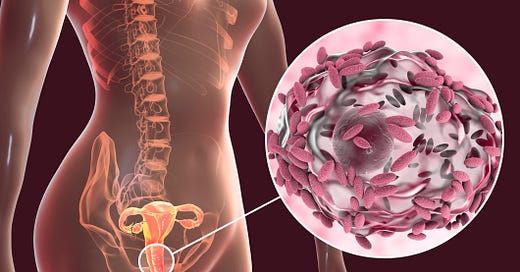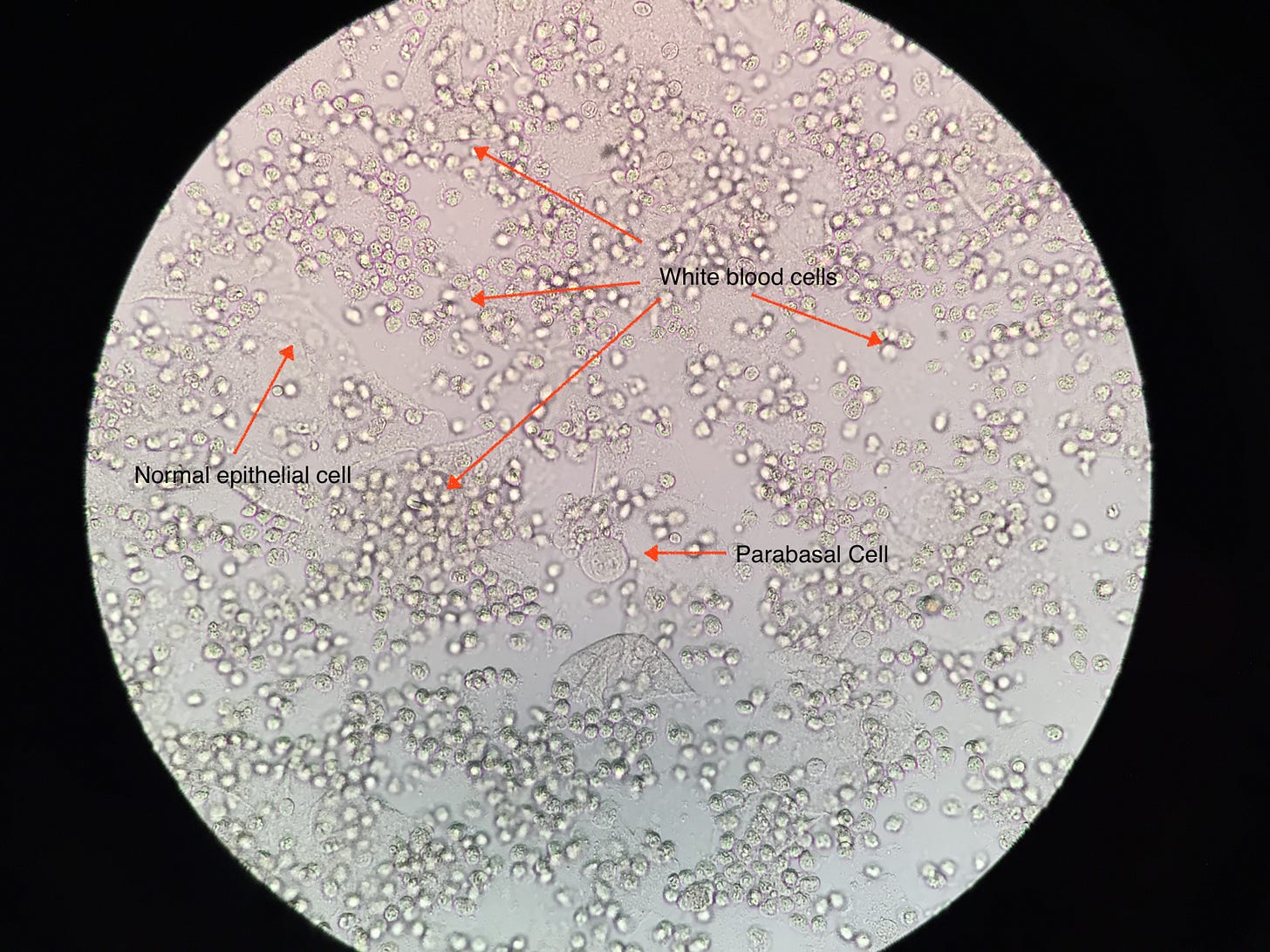Desquamative inflammatory vaginitis or DIV is a relatively newly described vaginitis (the term was first introduced in 1965). It is one of the more uncommon causes of vaginitis, so we don’t have as much data on it as we do for other causes of vaginitis, such as yeast and bacterial vaginosis.
The cause of DIV is as yet unknown. What we do know is that it is a dysbiosis, meaning the normal vaginal ecosystem is replaced with other bacteria, and there is inflammation. Whether the change in bacteria causes the inflammation or it is the other way around isn’t known. Despite a lot of recent study, it’s important to acknowledge that our knowledge of the vaginal microbiome is still in its infancy.
The hallmark of DIV is inflammation. There is a thick, yellowish vaginal discharge that can be so heavy at times that can feel like menstruation. Under the microscope the discharge is filled with white blood cells (a sign of excessive inflammation). There are also parabasal cells, which are immature cells from the lining of the vagina (mucosa). The presence of parabasal cells is typically seen when estrogen levels are lower. The vaginal pH is also elevated (normal is < 4.5).
This is what DIV looks like under the microscope.
Looking inside the vagina with a speculum, the walls of the vagina typically look red and sometimes even swollen. Again, this is a sign of inflammation. The discharge can irritate the vulva (the outside), causing vulvar redness and even erosions for some. The vaginal and vulvar irritation can be quite painful, even when there is no skin break down (meaning no erosions).
While DIV can happen at any age, it seems to be most common during the menopause transition. Changes in estrogen levels impact the healthy bacteria in the ecosystem, so that may be a trigger for some. Estrogen also impacts blood flow and many other mechanisms that keep the vagina healthy. Although it can’t be estrogen levels per se, otherwise we would see the most DIV for those who are over the age of 60, and we don’t. Also, if the one cause was low estrogen then estrogen would also treat DIV. While estrogen can sometimes help along with other therapies, estrogen by itself does not treat DIV. Personally, I suspect DIV is related to several factors and for some the fluctuations in estrogen associated with the menopause transition may be a kind of trigger or match, if you will.
It is always important to be aware of conditions that can look like DIV, so sometimes people with DIV are misdiagnosed with one of these other conditions and the reverse can be true, people are diagnosed with DIV when they really have something else. The most common conditions that look like DIV are:
Genitourinary syndrome of menopause. The low levels of estrogen affects the bacterial makeup of the vagina and causes inflammation. Sometimes it can be enough that there is a thick yellow discharge, redness, and even skin breakdown (erosions) just like with DIV. Although the discharge typically isn’t as heavy as with DIV. Low estrogen of menopause also produces the parabasal cells mentioned above.
Lichen planus. An autoimmune skin condition that most commonly affects the mouth and vagina, although it can affect skin on the body as well. In its earlier stages it can look exactly like DIV. A biopsy can sometimes help, but about 50% of the time with these skin conditions the biopsies are non specific. However, even when the biopsy doesn’t give a clear diagnosis, the pattern of inflammation can sometimes be helpful. I always tell people to think of a biopsy as one piece of the puzzle, not the whole picture.
Drug reactions. Medications can sometimes produce strange, inflammatory reactions that only impact one part of the body. There is a fairly complete list and good information on these reactions here. I have also seen several cases related to Rituximab, a medication for autoimmune conditions and cancer. These types of reactions can start years after being on a medication, so they are quite unpredictable. This can be a challenging diagnosis, because it can take months after stopping the medication to resolve. Sometimes a biopsy can help with the diagnosis.
Graft versus host disease. This is a reaction that happens after a bone marrow transplant where the donor's T-cells (graft) view the recipient’s (host) cells as foreign and attacks. This can result in significant inflammation and tissue damage in the vagina.
Vaginal fistula. A connection between the bowel and the vagina that can produce a profuse discharge and inflammation in response to bowel contents entering the vagina. A fistula is something that we typically only see in people who have had pelvic surgery, radiation, or who have medical conditions that affect their bowel, such as inflammatory bowel disease and diverticulitis.
It’s also important to rule out trichomoniasis and yeast as at times both of these infections can cause a profuse inflammatory response.
The first step with DIV is to make sure the diagnosis is correct. If someone is menopausal or in the menopause transition (perimenopause) and not using vaginal estrogen it may be reasonable to start with vaginal estrogen and then re-assess at 8 weeks to see if this is actually severe genitourinary syndrome of menopause. If after 8 week the changes of DIV are still present, then start therapy for DIV. In this situation I always recommend estrogen cream, as it has a higher dose versus the ring, vaginal tablets and vaginal capsules. If this resolves the issue then at that point the dose can be adjusted down to one of these other options if desired.
If someone has lichen planus in their mouth or a lot of erosions or ulcers, that raises the suspicion that this is vaginal lichen planus.
Assuming the diagnosis really is DIV, what are the treatments?
***********************************************************************************************************
This is an excerpt from today’s subscriber-only Ask Dr. Jen. To read the entire article and get full access to the archives, you can subscribe for $5 a month or $50 a year.






Where can I find the rest of this article? I am a paid subscriber and it cuts off before getting to treatements for DIV. Thank you!